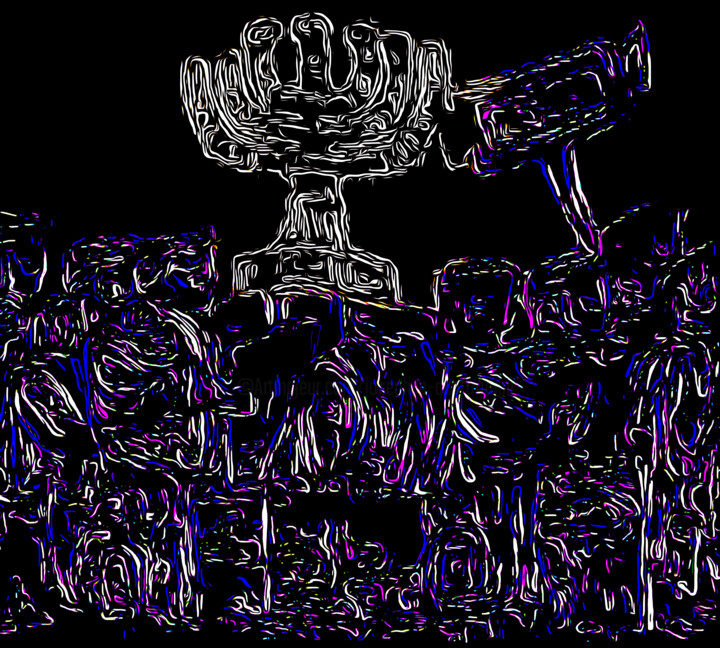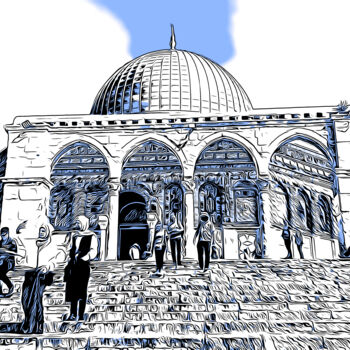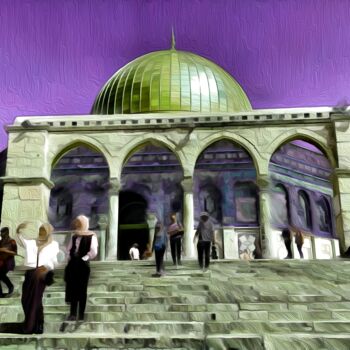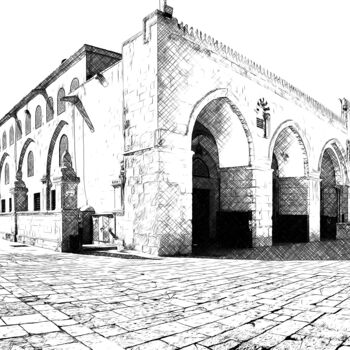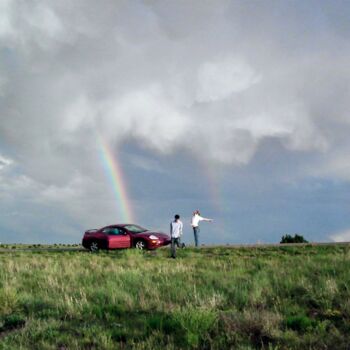Judaea Capta Black Menorah (2023) Digital Arts by J.A. Quattro (Qu4ttroStudio)
Sold by J.A. Quattro (Qu4ttroStudio)
This image is available for download with a licence
Sold by J.A. Quattro (Qu4ttroStudio)
-
This work is an "Open Edition"
Digital Arts,
Giclée Print / Digital Print
- Dimensions Several sizes available
- Several supports available (Fine art paper, Metal Print, Canvas Print)
- Framing Framing available (Floating Frame + Under Glass, Frame + Under Acrylic Glass)
- Artwork's condition The artwork is in perfect condition
- Categories Illustration World Culture
The Arch Of Titus, in Rome, stands in front of the Colosseum and commemorates the victory of Vespasian over Judea, which is when and where he was declared emperor, and depicts captive Jews carrying the golden Menorah (lamp stand/ candelabra) of the Jerusalem Temple, during his Triumph. The Menorah was placed in the Temple Of Peace, until the invasion of the Vandals, after which it went missing. It is believed by some that the Menorah was returned to Jerusalem and once kept within the Nea church, as Christian restitution to the G*d of Israel.
The captive Jews brought with them the skills that they employed in the building of the Colosseum itself, the greatest structure of Roman engineering, and they were soon able to buy their freedom and contribute to Roman society as citizens, making up between six and 10% of the total population of Rome. There were 11 synagogue communities within the city of Rome, some from as early as 200 BCE. The Jewish Roman community is the longest standing synagogue community in the world, at 2,200 consecutive years. An average of 45-70% of Roman era Italian DNA is found in Ashkenasy (Eastern European Jewish) DNA.
It was Roman Emperor Hadrian who named Judea “Palestine”, in 135 CE, after defeating the final but temporarily successful Bar Kochba messianic Jewish uprising that liberated Judea, but not Jerusalem, for three years. “Palestine” was a European term referring only to Judea under imperial occupation, not a nation, state, country or people, and not a term officially used recognized by any Arab or Muslim imperial occupiers who always ruled from their foreign capitals in Syria and Anatolia, just as Rome or any other imperial power never established its capital in Jerusalem. The Quran and the Imperial Islamic occupations referred to Judea and Jews, a nation and its people, as “Israel”, and used the menorah as the symbol on the coins minted in Islamic-occupied Israel. European maps of “Palestine” always described the area as “the holy land, Israel & Judea”, (under imperial occupation) which was also the only loosely connected Arabic use of the word “Falastin”, which never referred to a people, only the Israelite-Jewish holy land under imperial occupation.
The fall of Rome marked the end of the official imperial use of the term “Palestine” by any rulers of the region, until the 1922 League of Nations Mandate, administered by the British, for the restoration of the Jewish national homeland, which was intrinsically Zionist, meaning, “legal, internationally recognized, Jewish independence”, which includes Judea and Samaria, as well as Perea (trans-Jordan) according to the United Nations Charter, by virtue of adopting the League of Nations mandate principles that were based on previous, historic provincial borders, and because partition was rejected by the Arab and Muslim population, 70% of whom arrived illegally during the mandate era, while the British illegally banned Jewish immigration, so that they were sent to the concentration camps that the British-appointed Mufti of Jerusalem helped to devise. Arab ethno-states were first established by these same mandates for local independence, after the Western defeat of the Ottoman Empire, as were Muslim states partitioned based on religious majorities, such as Pakistan and Bangladesh being partitioned from what was only ever previously India.
Related themes
JerusalemRomeJudea CapturedSpoils Of WarJewish War Against Rome
J.A. Quattro has produced several 111 page, 12x12 inch, lay-flat photo books of Jerusalem, Israel; the PA & Jordan; Galicia, Spain; NYC & the USA. The photographer specializes in panoramas, cityscapes, landscape, architecture & ancient locations of spiritual significance. Images often feature stone arches, alleyways & ruins, some portraiture & journalistic subjects. The photographer-artist creates, designs, & edits their original, digital photo paintings of their original photographs.
Early personal influences on Quattro’s development, besides a musician father & a legal professional mother who could draw & who taught religion, were two neighbors. One was a photographer named Artie Van Blarcum, who was featured, along with Quattro’s childhood home, in a photo biography by photographer George Tice. The other was a ceramics maker & painter named Jackie, with whom the young photographer & future digital artist began a weekly class for neighborhood children. Quattro & Jackie had both been born to Ashkenasy Jewish mothers, but were raised as Christians, which has come to shape the uniquely mixed experience and perspective evident in much of Quattro’s work featuring images that have meaning to many peoples’ identities and many people’s own identities.
As a 17 year old Catholic High School student, in 1995, Quattro took part in the administering of the Eucharist, documenting the Papal Mass given by Pope John Paul II, at Giants Stadium. While taking early admission college credits from Saint Peter’s University, Quattro simultaneously attended night & weekend classes at Orthodox Jewish Seminary, going on to study at a Yeshiva College, in the Old City of Jerusalem, Israel. There is where the artist’s identity & interest in capturing images converged & emerged as a calling, combining history, spirituality & visuality. Quatto continued involvement in organizations that offered opportunity to combine learning, traveling, volunteering and devotion to developing as a photographer and as a person, which included working for Madonna’s children’s charity, in 2007.
-
Nationality:
UNITED STATES

- Date of birth : 1978
- Artistic domains: Works by artists with a certified artist value, Works by professional artists,
- Groups: Certified Artists Professional Artist Contemporary American Artists

